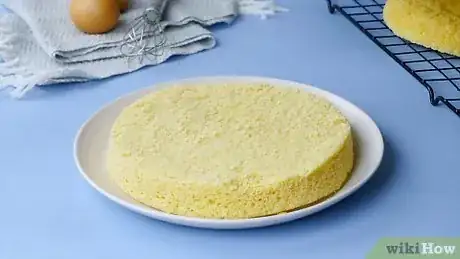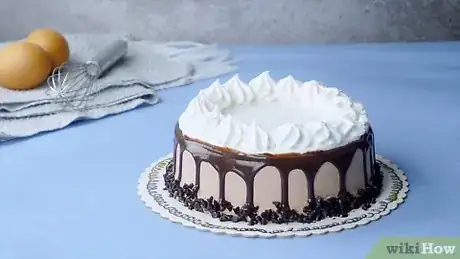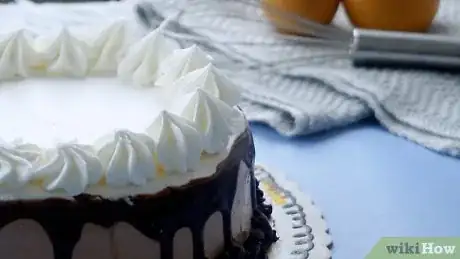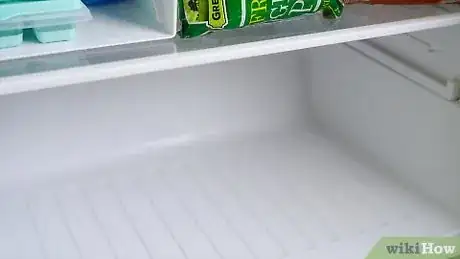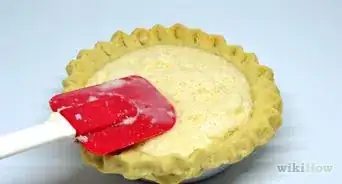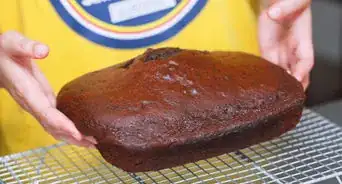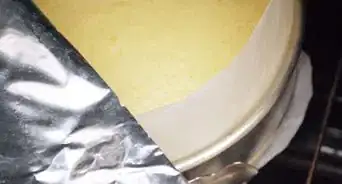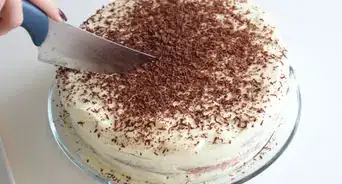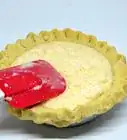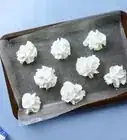This article was co-authored by Maria Short. Maria Short is a Baker and the Owner of Short N Sweet Bakery & Cafe in Hilo, Hawaii. With over 24 years of experience, she specializes in specialty desserts and wedding cakes. She graduated from L’Academie de Cuisine’s Pastry Arts Program with honors and studied at Baltimore International Culinary College. In 2019, Maria competed in the 6th season of the Food Network’s Holiday Baking Championship. In 2010, she had a cake named one of “America’s Most Beautiful Cakes” by Brides magazine.
wikiHow marks an article as reader-approved once it receives enough positive feedback. This article received 11 testimonials and 100% of readers who voted found it helpful, earning it our reader-approved status.
This article has been viewed 886,539 times.
Freezing a cake can be a highly useful thing to do when you don't plan on eating your baked goods right away. Perhaps you'd like to keep it for your friend's birthday party the following week. Or maybe you'd like your perfect cake for a special dessert. Whatever your reasons, you've come to the right place. Read on to find out how to freeze cakes, and what to look out for in the process. When the time comes, defrost your cake correctly and enjoy.
Steps
Freezing A Baked Cake To Frost Later
-
1Let your cake cool. Before you can freeze your cake for later consumption, you must let it cool. So if you've just baked a cake, put it aside for about three hours. Lightly place your hand on it to make sure it's cool to the touch[1] .
- If you're freezing a store-bought cake, or a cake that has already cooled, skip this first step.
-
2Determine what kind of cake you're freezing. Most cakes will freeze well due to the high fat content in them. If your cake doesn't have fat (like fat-free cakes), it won't freeze well and you should avoid putting it in the freezer.Advertisement
-
3Select the right wrapping to freeze it in. Your cake has to be protected from freezer condensation, so using a moisture-proof wrapping is key to preserve your cake's flavor and texture. You have a few options[2] :
- Plastic wrap: this wrapping material is always well suited, but might require multiple layers as moisture might get in. Plastic wrap is easy to wrap and fairly durable.
- Aluminum foil: this wrapping foil is probably one of the best barrier films as it's impervious to light, moisture and bacteria. One major disadvantage is that it tears very easily.
- Place the wrapped cake into a metallic tin, if desired. This protects the cakes from being knocked by other items, makes it very easy to find and provides added protection from moisture and freezer odors, such as seafood.
-
4Extend the wrapping of your choice onto a flat surface, preferably in your kitchen. Then, take the pan with your cake in it, and flip it upside down. Your cake should come out of the pan without much work on your end.
- If the cake doesn't come out right away, get a knife and slide along the edges of your pan (between the pan and the actual cake).
- If you previously removed your cake from its baking pan, skip this step.
-
5Wrap your cake. Now, simply use your wrapping to envelop the cake. Make sure you're wrapping your cake tightly, without much room for air between the cake and the wrapping[3] .
-
6Place your wrapped cake into the freezer. You're now ready to freeze your cake for storage. Make sure you have enough space and try not to position your cake next to foods with strong flavors and odors (like seafood). Your cake could well absorb some odors, and even flavors, so you should ideally have a spot where your cake won't be around other food items.
- You might even consider cleaning your freezer before placing your cake in it. This will greatly improve your cake's flavor and odor retention.
-
7Keep your cake in the freezer within certain time limits. A cake will generally freeze well for a few months, but not more than that. Whilst freezing initially retains the moisture of a pre-baked cake, cakes will tend to dry out after two months of freezing and you can expect the flavor to change at around four months.
- Once you're ready to frost your cake, simply take it out of the freezer and let it thaw for about 40 minutes. Then, frost it to your liking.
Freezing A Frosted Cake
-
1Let your cake cool. Before you can freeze your cake for later consumption, you must let it cool. Ideally, you should put your cake aside for about three hours. Lightly place your hand on it to make sure it's cool to the touch[4] .
- If you're freezing a store-bought cake, skip this first step.
-
2Determine what kind of cake you're freezing. Most cakes will freeze well due to the fat content in them. If your cake doesn't have fat (like fat-free cakes), it won't freeze well and you should avoid putting it in the freezer.
-
3Make space in your freezer. Your cake should ideally not touch any other foods while it freezes. If it does, it'll likely absorb the odor and flavor of those food items. This is why it might be a good idea to have an entire shelf or section reserved just for your cake.
- Frosted cakes might also take up more space than unfrosted cakes, depending on how high the frosting is.
-
4Place your cake into a baking pan or metal tin. Then, place it in the freezer unwrapped for about 4 hours. Then, remove the cake from the freezer.
-
5Extend plastic foil on a flat surface in your kitchen. Try to cut a piece of foil that will nicely wrap around all sides of your frosted cake.
-
6Wrap your cake. Loosely cover your entire cake with plastic foil. Make sure that the whole cake is properly covered, but that you don't flatten the frosting too much.
-
7Wrap your cake a second time. It's a good idea to add an additional layer of plastic foil around your cake to protect the shape and keep other odors in your freezer from sticking to your cake.
-
8Place your cake in an airtight plastic food container. You can also freeze the cake without the added protection of tupperware, but a plastic container will keep your cake in better shape. After wrapping the cake into plastic foil, put it into the plastic container and place it in the freezer.
-
9Keep your cake in the freezer within certain time limits. A cake will generally freeze well for a few months, but not more than that. Whilst freezing initially retains the moisture of a pre-baked cake, cakes will tend to dry out after two months of freezing and you can expect the flavor to change at around four months.
Community Q&A
-
QuestionCan I freeze a chocolate ganache cake with cream cheese filling?
 QamarTop AnswererYes, although the cream cheese filling may take a while to defrost.
QamarTop AnswererYes, although the cream cheese filling may take a while to defrost. -
QuestionIf I bake a cake in a tin pan, do I have to take it out of the pan to freeze it?
 Community AnswerIf you want to have it freeze faster, then yes. But for a longer time, leave it in the pan. No harm, no foul. Also, when you take cake out of the oven, it still cooks in the pan heating it up.
Community AnswerIf you want to have it freeze faster, then yes. But for a longer time, leave it in the pan. No harm, no foul. Also, when you take cake out of the oven, it still cooks in the pan heating it up. -
QuestionCan dump cakes be frozen before icing?
 Community AnswerYes, they can, and this would work better than freezing after icing.
Community AnswerYes, they can, and this would work better than freezing after icing.
Warnings
- Cakes lacking fat/oil freeze poorly, including fat-free whisked sponges.⧼thumbs_response⧽
- Except for lime, fruit toppings on cakes are unsuitable to freeze.⧼thumbs_response⧽
Things You'll Need
- Appropriate wrapping (plastic, aluminum)
- Baking pan or metal tin (optional)
- Freezer
References
About This Article
If you want to freeze a cake before you frost it, start by letting the cake cool and then wrapping it in aluminum foil. Make sure you wrap the cake tightly so there's no room for air to get in. Then, place the wrapped cake in the freezer and keep it clear of other food items so it doesn't absorb flavors. Keep your cake in the freezer for up to 2 months, because it will lose its moisture if you freeze it any longer. When you're ready to use the cake, let it defrost for 40 minutes before frosting it. To find out why you should avoid freezing fat-free cakes, keep reading!

